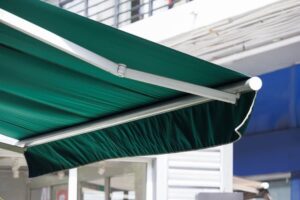You rely on your retractable awning to provide relaxing shade on sunny days, as well as add ambiance to your overall curb appeal. If components aren’t functioning as they should or you notice damage, Giglio Awning can help you determine whether a replacement is warranted. Here, we discuss when to consider a retractable awning replacement for certain parts or the entire system.

Malfunctioning Technical Components
Technical issues are an initial indicator that a retractable awning replacement could be necessary. Common technical issues include not extending, retracting completely, extending, or retracting when they shouldn’t be. Also, look out for problems with the following:
- Arm mechanism: An arm mechanism could bend or break, or its bearings can become loose or wear out.
- Limit switches: Faulty connections or alignment problems within the switches can cause an awning to stop moving before it completes its extension or closing process.
- Motors: A motor can overheat or have a shorted wire or failing gears. Motor brushes also wear out over time. These problems can cause your awning to move in a jerky fashion as it extends or closes.
- Sensors: A power outage can disrupt a sensor’s ability to detect sun, wind, or other weather conditions.
- Tracks: Dirt or debris can jam an awning’s tracks or weather conditions may also misshape a track. Tracks stop running smoothly due to poor lubrication or the awning may pop out of a track.
- Power supply: This could come from a damaged power cord, connection issues, or weak voltage.
Noticeable Wear and Tear
A retractable awning’s framework structure is made from durable material, which will still experience wear and tear eventually. Weather isn’t the only force that could impact an awning’s framework. Bees and other insects that nest within a retractable awning can also negatively impact the framework structure.
Without proper upkeep, your awning’s framework could become bent, discolored, stained, or rusted. Rust, in particular, is a concern that can lead to other issues. It may develop in awning cables, joints, or welds, causing the metal to age rapidly. It could also be hazardous for anyone underneath an awning if the framework breaks.
Damaged Fabric
It’s important to inspect retractable awning fabric regularly. If you notice any fabric damage, you should get it repaired before storing the awning away. Fabric, especially if constantly exposed to different weather conditions, can easily become compromised.
While sometimes there is only minor fabric damage, other cases could be more severe and may necessitate a complete repair. Consider the following points to help you evaluate your fabric:
- Multiple holes within an awning are a sign to replace it.
- A loose fabric thread or string could latch onto something and cause a tear.
- Fabric may start sagging due to debris or water weighing it down, or when it is overextended.
- If you see sun splotches and discoloration, it’s a sign the fabric is weakening.
Awning fabric can also become damaged simply due to age, with the typical lifespan being five to 15 years.
Lingering Mold and Mildew
Over time, exposure to heat and precipitation could cause mold and mildew to form within a retractable awning. Improperly rolling or storing could also cause this. It’s important not to close an awning shade until it dries completely. It is also crucial to treat mold and mildew quickly to prevent it from spreading. Mold and mildew that form over time will require an awning to be replaced.
Contact Us for Retractable Awning Replacements and Installations
It is important not to ignore any issues you have with your retractable awning, as they can lead to further problems. Turn to Giglio Awning for repair or replacement of your retractable or custom awning. We proudly serve homeowners in Cape May, Atlantic, Ocean, Burlington, and Monmouth Counties in New Jersey. To learn more about our fast installation times, retractable awning replacements, and other services, contact us today.
